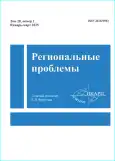Labor market and employment in the Jewish Autonomous Region: its state and development trends
- Autores: Averina O.V.1
-
Afiliações:
- Институт комплексного анализа региональных проблем ДВО РАН
- Edição: Volume 28, Nº 1 (2025)
- Páginas: 56-69
- Seção: ECONOMY
- URL: https://bakhtiniada.ru/1605-220X/article/view/302354
- DOI: https://doi.org/10.31433/2618-9593-2025-28-1-56-69
- EDN: https://elibrary.ru/YSOCWX
- ID: 302354
Citar
Texto integral
Resumo
Modern labor market is very important in the economic system of society, shaping supply and demand between employers and employees, which, in turn, affects the level of competitiveness, both on a national scale and at the regional level. In this paper, the author analyzes and assesses the labor and employment market current state in the Jewish Autonomous region identifying the main trends in its development. Within the framework of the JAR labor market analysis and comparison with the Far Eastern Federal District and the Russian Federation labor markets, it has been determined the key indicators of its formation and development, namely: the labor force size; the number and level of employees by industries and types of economic activity, the level of education at age groups; the size and level of unemployment, the level of registered unemployment; the level of wages, labor migration and demographic situation in the region. The study of labor market in the Jewish Autonomous region over the past 7 years has made it possible to see its structural transformation and determine the main trends for its formation and development. The author has also identified main problems and imbalances in the JAR labor market: a decrease in the labor force size over the entire study period; the employed population reduction, including young people, with negative migration; high qualified staff shortage – both among skilled workers and senior management personnel, and other problems.
It is concluded that without a well-thought-out state policy in the field of population retention, currently, it is almost impossible to solve the problem of labor resources and staff shortage in the Jewish Autonomous region. The article presents the factual material analysis, in particular: the labor market main indicators, employment and unemployment in the Jewish Autonomous region, the Far Eastern Federal District and the Russian Federation in dynamics for the period of 2018–2023.
Sobre autores
O. Averina
Институт комплексного анализа региональных проблем ДВО РАН
Autor responsável pela correspondência
Email: oaverina@yandex.ru
ORCID ID: 0009-0006-1207-9387
Rússia, ул. Шолом-Алейхема 4, г. Биробиджан, 679016
Bibliografia
- Agabekyan R.L. Features of the development of the Russian labor market in new geopolitical conditions. Ekonomika: vchera, segodnya, zavtra, 2022, vol. 12, no. 5 А, pp. 191–197. doi: 10.3467/AR. 2022.37.58.044 (In Russ.).
- Deduh V.I., Garmashova E.P. Trends in the Development of the Labor Market of the City of Sevastopol. Vestnik Kerchenskogo gosudarstvennogo morskogo tekhnologicheskogo universtiteta, 2023, № 2, pp. 189–199. doi: 10.26296/2619-0605.2023.2.2.018 (In Russ.).
- Kashepov A.V. The Labor Market and Employment in Russia in 2020–2024. Sotsial’no-trudovye issledovaniya, 2024, no. 57, pp. 43–52. doi: 10.34022/26-58-3712-2024-57-4-43-52 (In Russ.).
- Kozhemyako S.V., Alpatova E.S. Modern Problems and Prospects of Labor Market Development. Moskovskii ekonomicheskii zhurnal, 2023, no. 3, pp. 512–527. doi: 10.55186/2413046X_2023_8_3_139 (In Russ.).
- Lanets T.N. Assessment of Structural Shifts in the Regional Labor Market of the Far East and the Khabarovsk Territory. Vlast’ i upravlenie na Vostoke Rossii, 2022, no. 2 (99), pp. 87–100. doi: 10.22394/1818-4049-2022- 99-2-87-100 (In Russ.).
- Mironenko O.V., Komarova V.V., Lezhenina A.A. Main trends in the ratio of supply and demand in the regional labor market of the Russian Far East. Ekonomika truda, 2023, vol. 10, no. 9, pp. 1317–1330. doi: 10.18334/et.10.9.119224 (In Russ.).
- Labor force, employment and unemployment in Russia. Official publications. Federal’naya sluzhba gosudarstvennoi statistiki. Available at: https://rosstat.gov.ru/folder/210/document/13204 (accessed: 18.02.2025). (In Russ.).
- Regions of Russia. Socio-economic indicators. Federal’naya sluzhba gosudarstvennoi statistiki. Available at: https://rosstat.gov.ru/folder/210/document/13204 (accessed: 18.02.2025). (In Russ.).
- Romanyuk E.V., Voloshin A.I., Lisutin O.A., Trusevich E.V. How digitization affects the Russian labor market. Ekonomika truda, 2025, vol. 12, no. 1, pp. 11–24. doi: 10.18334/et.12.1.122273 (In Russ.).
- Labor market and employment of the population. Upravlenie Federal’noi sluzhby gosudarstvennoi statistiki po Khabarovskomu krayu, Magadanskoi oblasti, Evreiskoi avtonomnoi oblasti i Chukotskomu avtonomnomu okrugu. Available at: https://27.rosstat.gov.ru/folder/25661 (accessed: 18.02.2025). (In Russ.).
- Labor resources, employment and unemployment. Federal’naya sluzhba gosudarstvennoi statistiki. Available at: https://rosstat.gov.ru/labour_force# (accessed: 12.02.2025). (In Russ.).
- Khvan I.S., Medvedev E.A. The state of the labor market as an indicator of the use of human resources in the Far Eastern Federal District. Vlast’ i upravlenie na Vostoke Rossii, 2024, no. 3 (108), pp. 68–75. doi: 10.22394/1818-4049-2024-108-3-68-75 (In Russ.).
- Yanik A.A., Popova S.M., Karpova S.F. Regional Labor Markets in Russia under New Conditions: Problems and Possibilities of Path Dependence Overcoming. DEMIS. Demograficheskie issledovaniya, 2023, vol. 3, no. 4, pp. 165–182. doi: 10.19181/demis.2023.3.4.10 (In Russ.).
Arquivos suplementares









